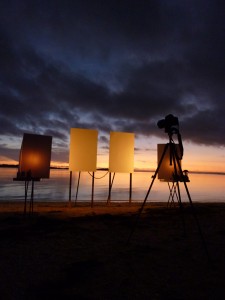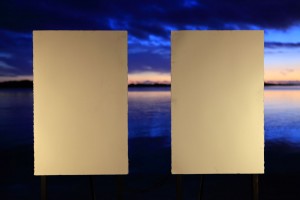A painting event that cannot reconcile the relation between a real time experience and the artifact; between the materiality of time, place, sensuality and the media with the simulacra on the screen. This event could not have happened—it is all together something else from those 10 minutes of blacking out the paper on a deserted beach. The artifacts are not evidence of anything: the video text and the painting media on watercolour paper may seem indexed to a past action ‘that-has-been’, but they are mere representations of an idea. The presumption of an indexical link between the event and the video text may be understood as a distortion of the sign, a fabrication based on the idea of ‘actuality’.
The event that may have taken place now has little to do with the video text, the only link was temporary during the 10 minutes of the action. Now the link is a fictionalization, a distortion on the expectations of how the medium is commonly read. Then what is the reader looking at? The signifiers are multiplying and shifting, while the referent is incoherent and mutable. The point is that the signs do not need a referent, thus severing any perceived link to an actual happening.
Yet there is a double signing for the knowledge of this sensory experience sits parallel to the artifacts. The bodily visceral qualities of the sensory experience are invisible to the reader, a shadow that sits behind the image, obscured by the image. The reader’s body is a new body, a palimpsest for the shadow behind the image that they cannot know. This obscured shadow is the punctum of the senses: the sound of wind, waves, and birds, the smell of the sea, the smooth wet sand under foot, the brushing of black pigment, wet across the white paper mounted on stiff board. I can feel the board gently moving under brush, the light from the lanterns bushing across the paper. I have little sight, except for the white becoming black. The blackness of the night becomes the blackness of the paper, they become one.
The pair of artifacts on paper have emerged from an event to which they no longer refer, while their relation to the video text is inconclusive: how can the reader assume these paintings are the ones depicted in the video text? Where is the proof? These two texts on paper float in a realm that is another kind of parallel. They sit side by side on the opposite side of the room to the video projection, facing off through the darkness, but the texts on paper and the screen seem relational only in size. What is the possibility for the reader to have no context except a room in a gallery? An entirely new sensory experience emerges, new texts can be written. There is no past.



